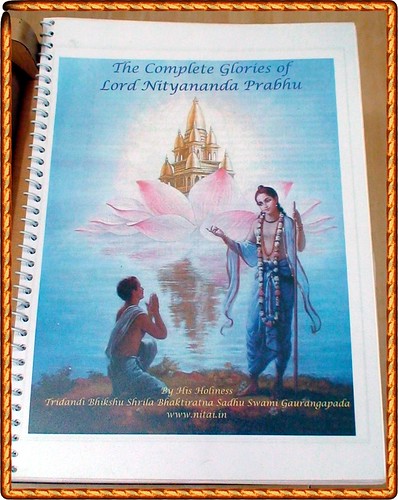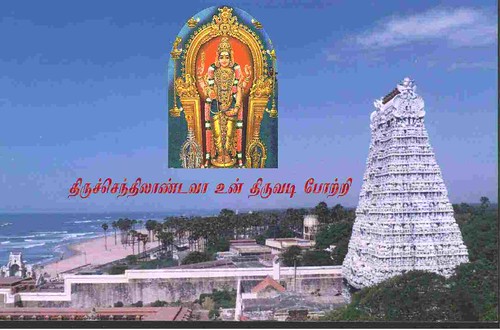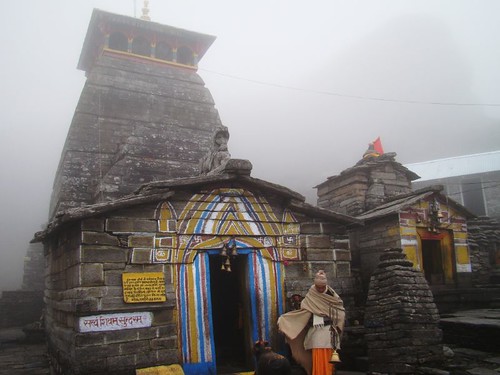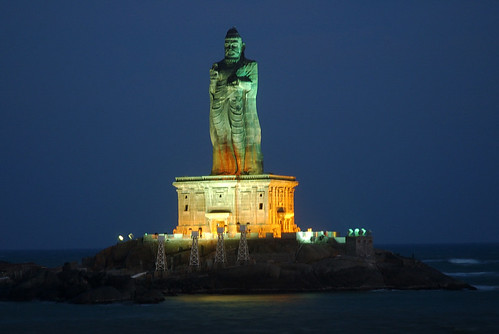Photo: 'The Complete Glories of Lord Nityananda Prabhu', book transcribed and published from the audio lectures of Swami Gaurangapada by Bhushan Nityananda Dasa.
The Vaishnava Saint Nityananda Rama, also known as Sri Nityananda or Prabhu Nityananda, is famous as a saint, social reformer and religious and spiritual figure within the Gaudiya Vaishnava tradition. His disciples and followers believe that Nityananda was an incarnation of Balarama. Nityananda is also considered as the most merciful incarnation of the Supreme Personality of Godhead.
Sri Nityananda was Chaitanya Mahaprabhu's friend and disciple. They are usually mentioned together as Gaura-Nitai (Gaura for Chaitanya and Nitai being short form of Nityananda) or Nimai-Nitai (Nimai for Chaitanya).
Chaitanya Mahaprabhu (1486-1534), also known as Sri Krishna Chaitanya and Sri Chaitanya, was a saint and social reformer in eastern India, an area comprising of the present day Bangladesh and the Indian States of West Bengal, Bihar, Jharkhand and Orissa. The followers of Gaudiya Vaishnava tradition believe that he was an incarnation of Lord Krishna. Sri Chaitanya was a notable proponent of the Vaishnava school of Bhakti Yoga based on the philosophy of Bhagavata Purana and Bhagavad Gita. He mainly worshipped Radha and Krishna and popularized the chanting of Hare Krishna Mantra.
Nityananda Prabhu was born (around the year 1474, no exact date is known) to a Bandyaghati Brahmin, Mukunda Pandit (aka Hadai Pandit) and Padmavati in Ekachakra, a village in the Birbhum District of West Bengal in India. His had great talent for singing Vaishnava hymns (Bhajan) from a very early age. According to legends and folklore, as a youth, he became well known for his dramatic presentations of Lord Rama's stories, along with the other boys of the village. Nityananda used to play the role of Lakshman, Rama's younger brother.
At the age of thirteen, Nityananda left home to accompany Lakshmipati Tirtha, a travelling saint (Sannyasi) on his pilgrimages. Nityananda's father, Hadai Pandit, had offered Tirtha anything he wished as a gift, for which Tirtha wanted Nityananda to follow him in his pilgrimage to holy places. As he had already promised, Hadai Pandit reluctantly agreed to the sage’s demand and Nityananda joined him in his travels. This marked Nityananda's long physical and spiritual journey through India, and brought him in contact with great Gurus of the Vaishnava tradition. Besides Lakshmipati Tirtha, who at some point of time initiated him, he was also associated with Tirtha's other disciples such as Madhavendra Puri, Advaita Acharya and Ishvara Puri.
There are many legends and folklore on Nityananda and Chaitanya. But the Nityananda’s encounter with the brothers Jagai and Madhai is one of the most well known tales highlighting the compassion and love of Nithyananda. Though there are many versions of the story, but traditional tale can be summarized as follows.
Once, Nityananda was chanting the name of Lord Krishna on the streets. Then two irreverent drunk brothers Jagai and Madhai attacked Nityananda. Madhai threw an earthen pot which wounded Nithyananda’s forehead. At this point Nityananda is believed to have said in Bengali, "Merechhish kolshir kana, tai bole ki prem debona?" (“Shall I stop giving you love because you have hit me with an earthen pot?”). When Chaitanya came to know of the incident, he was enraged, and wanted to kill the brothers with his divine Chakra. But Nityananda begged him to pardon them, and saved them. The brothers were converted to civilized loving persons by Nityananda's compassion, and they became Chaitanya's disciples.
Prabhu Nityananda married Vasudha and Jahnava, two daughters of Suryadasa Sarakhela and he settled down in Khardaha. By his first wife Vasudha, Nityananda had a son, Virabhadra (Virachandra) and a daughter, Ganga. Virabhadra was later initiated to Vaishnava traditions by Jahnava.
The life and works of Chaitanya and Nityananda have had great religious and cultural impact in Eastern India, especially in Bengal. They are credited with the revival of Hinduism, which was plagued by the caste system, which they denounced. A large chunk of Vaishnava literature, regarded as one the finest literary heritage of medieval Bengal, was contributed by them and their disciples.
Now they have disciples and followers through out India and abroad, and institutions to spread their teachings. The idol of Nityananda and Chaitanya in the Radha-Krishna Temple in Belgium is quite famous. Also, there is a Gaura-Nitai Shrine at ISKCON Temple in Delhi.













